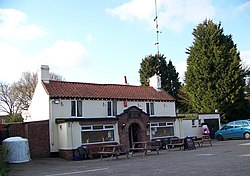Fritton, Suffolk
| Fritton | |
| Suffolk | |
|---|---|
 The Decoy Tavern near Fritton Decoy | |
| Location | |
| Grid reference: | TG467000 |
| Location: | 52°32’31"N, 1°38’12"E |
| Data | |
| Post town: | Great Yarmouth |
| Postcode: | NR31 |
| Local Government | |
| Council: | Great Yarmouth |
Fritton is a village and ancient parish in the very north-east of Suffolk, on the border with Norfolk. It is situated some seven miles south-west of the town of Great Yarmouth in that county, and nine miles north-west of Lowestoft.
Today the village forms part of the civil parish of Fritton and St Olaves.
History
Caldecott Hall, now a hotel rebuilt in the Victorian era, was a substantial manor house as early as the fifteenth century. It belonged to Sir John Fastolf, the original of Shakespeare's Falstaff. The Paston Letters record the bitter struggle between the Paston and Debenham families over its inheritance.
During World War II, Fritton Decoy was requisitioned by the 79th Armoured Division for the secret training tank crews of DD tanks, specially amphibious modified tanks, which would play a significant role in the D Day Landings of 6 June 1944. Between the spring of 1943 and the summer of 1945, over 2,000 men from a number of British, Canadian and American regiments / battalions came to Fritton Decoy to be trained in the operation of these tanks.
Outside links
| ("Wikimedia Commons" has material about Fritton, Suffolk) |

This Suffolk article is a stub: help to improve Wikishire by building it up.
